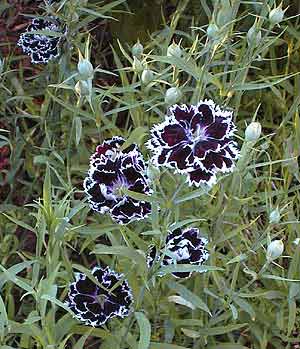Dianthus plumarius 'Velvet 'n Lace'
COTTAGE PINKS, GRASS PINKS
Family: Caryophyllaceae
Pronounced: dye-AN-thus ploo-MAH-ree-us
Quick Jumps
Growing Guide
Rainy Side Notes
GROWING GUIDE

Origin:
Garden.
Plant Group:
Perennial.
Hardiness:
Sunset zones: 1-24.
USDA zones: 3-9 (perennial in zones 6-8 on the West Coast.)
Mature size:
Height: 12 inches (30 cm).
Width: 12 inches (30 cm).
Flowering period:
June to August.
Flowering attributes:
Highly fragrant, velvety purple to burgundy (some look black) flowers with white ruffled edges.
Leaf attributes:
Lance shaped, green to blue-gray leaves.
Growth habit:
Clump forming.
Light:
Full sun or partial light shade.
Soil:
Humus rich, moist, well-drained, neutral ph soil.
Feeding:
Side dress with compost or manure and a complete organic fertilizer in spring. Dianthus benefits from a sprinkling of lime in the fall.
Propagation Methods:
Sow seed in late winter to early spring and germinate at 55-59°F (13-15°C). | Take cuttings in summer.
Pests and Diseases:
Blister beetles may be a problem. In poorly drained soils, crown rot and fungal diseases may be a problem.
Rainy Side Notes
Dianthus comes from the Greek words Di–of Zeus, and anthos–a flower. Plumarius means plume, for its fringed petals.
Most dianthus, including D. 'Velvet 'n Lace', need a well drained neutral soil. Be careful when cultivating around its shallow root system so as not to damage the roots. Divide every two to three years.
This is a short-lived perennial but is easy to start from seed. I have grown this compact beauty off and on for the last 15 years and have not tired of its presence in my garden. It blooms for a long period between late spring and autumn. Beautiful and long blooming, what more could you ask for in a perennial?
Photographed in author's garden.

Gardening for the Homebrewer: Grow and Process Plants for Making Beer, Wine, Gruit, Cider, Perry, and More
By co-authors Debbie Teashon (Rainy Side Gardeners) and Wendy Tweton
Copyright Notice | Home | Search | Perennials

